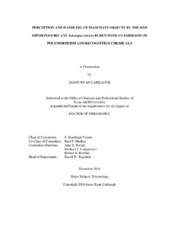| dc.description.abstract | Invasive ant species can cause serious impacts ecologically and economically. One of the most documented invasive ant species is the red imported fire ant Solenopsis invicta. This invasive ant species has an impact on people, agriculture, and wildlife. This dissertation addresses how S. invicta perceives and handles objects in their environment. More specifically, studies investigated if workers can discriminate colors, how well polymorphic workers handle different sizes of objects, and behavioral responses by workers on recognition chemicals. The results of these studies can be used to make more efficient baits to reduce their populations.
The color discrimination study consisted of five colored glass beads: blue, green, yellow, orange, and red. Workers of S. invicta dug into colored glass beads, which consisted of equal proportions for two colors. Any color glass beads brought to the surface by the workers were counted. Workers can discriminate colors and have preferences for green, orange, and red.
Polymorphic workers of S. invicta were observed in how well they handled different sizes of glass beads when digging and foraging. For digging, the glass bead sizes consisted of 0.25, 0.50, 1.0, and 2.0 mm, while for foraging, the glass bead sizes consisted of 0.50, 1.0, and 2.0 mm. Results indicated that smaller workers can handle the smaller beads, while the larger workers can handle the larger beads. When digging and foraging, the most preferred bead size was 0.50 mm.
The behavioral response by S. invicta workers to recognition chemicals was determined when the chemicals were placed on glass beads. Recognition chemicals consisted of cuticular hydrocarbons and polar cuticular lipids. Glass beads treated with the recognition chemicals, along with control glass beads, were placed in three locations of the colony’s environment: (1) near the food sources, (2) near the nest entrance, and (3) inside the nest. Workers were more attracted to the glass beads treated with recognition chemicals than the control glass beads. Workers of monogyne colonies were more attracted to cuticular hydrocarbons compared to polar cuticular lipids, while there was no difference between the recognition chemicals and the responses from workers of polygyne colonies. | en |


